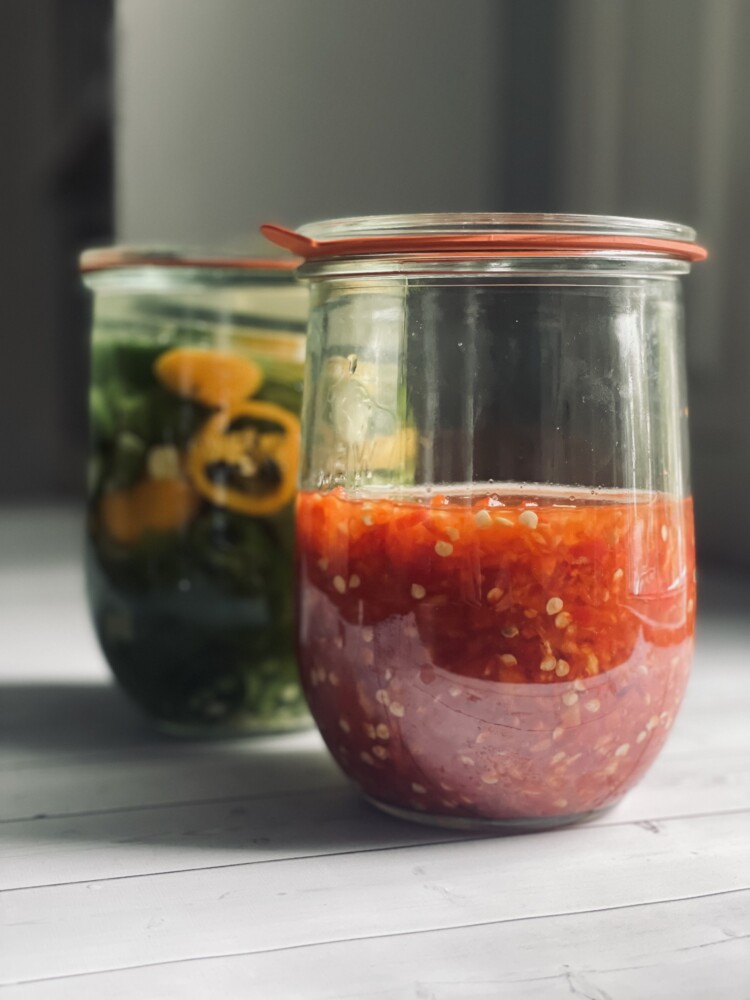When we met 10 years ago as new neighbors on West South Street in Carlisle, Pennsylvania, my friend Ann and I firmly sat at opposite ends of the spiciness spectrum. She, a native Californian, was a fire eater and I, with my solid New England roots, was a spice wimp. Having spent a significant portion of the last decade cooking and eating adventurously together in Carlisle, Cairo and Camden, Ann admits I am less wimpy than I used to be. I credit my movement up the Scoville Scale to the ever-increasing number of interesting hot sauces, chili pastes and chili crisps on the market. In addition to adding heat, these sauces bring other, more subtle flavors, and even a bit of funk to the table.
My new favorite hot sauces are the lacto-fermented variety. There are basically two methods for making a hot sauce. One involves vinegar and the other taps into the lacto-fermentation process. Vinegar-based hot sauces – national brands like Cholula or Valentina and local brands like Portland-made Captain Mowatt’s and Maine Saucery – combine chilies with vinegar (plus other fruits, vegetables, aromatics and spices). These are inherently shelf stable thanks to the acidity of the vinegar, which inhibits spoilage.

Onggi, a store on Washington Avenue in Portland that sells both fermented products and fermentation gear, offers a variety of local and domestic hot sauces. Photo by Christine Burns Rudalevige
Fermented hot sauces – well known ones like Tabasco and Sriracha and Maine-made ones like Resurgam, Solsa and Thirty Acre Farms, produced in Portland, Newcastle and Bremen respectively – require mixing chopped pepper with salt, and letting them sit in a dark place for days, even months, before blending them into a pourable condiment. While food historians say it’s likely indigenous people of Central and South America fermented chilies thousands of years ago, there is no physical evidence of fermented hot sauces being made until the 16th century, when Western traders started shipping chilies worldwide. The age-old practice has come back into vogue as the health benefits and flavor-boosting qualities of live cultures in fermented foods become more evident to more eaters.
Because the beneficial bacteria that adds the funk to these fermented sauces are still alive even once they are bottled, the flavor deepens as they sit in your fridge, says Erin Zobitz, who with Amy Ng and Marcus Im, owns Onggi, a shop on Washington Avenue in Portland that specializes in fermented foods and fermenting gear. Onggi sells several brands of small batch fermented hot sauces from New York, California and Maine. Zobitz conducted a Zoom class in July on how to make your own and recommends Kristen and Christopher Shockey’s book “Fiery Ferments: 70 Stimulating Recipes for Hot Sauces, Spice Chutneys, Kimchis with Kick and other Blazing Fermented Condiments” to anyone looking to learn how to balance different types of chilies to produce fermented hot sauces and use them in everything from morning smoothies to evening desserts. The Shockeys also supply an illustrated guide on how to identify and remedy, if possible, some of the problems that arise during lacto-fermentation projects – when the brine looks like snot or when the mash separates from its liquid, for example.
The summer of 2021 has been a particularly good year for hot peppers, the farmers manning the stands I frequent at the farmers market say. I’ve embarked on a mission to preserve some of that bounty in a formula that involves both spicy red and green chilies and a few sweet bell peppers to temper the finished product for my palate. I’ve finely chopped medium hot red Krimzon Lee chilies, one fiery habanero, and three red baby bell peppers, and combined the mash with sea salt. You need at least two percent of the chilies’ weight in salt for a safe ferment, but I like my sauces salty, so I added five percent of the chilies’ weight.
In a second jar, I combined sliced medium hot Sandia Green, jalapeno, sweet yellow bell peppers, garlic and ginger and am fermenting them in a salty brine made from 2 tablespoons sea salt and a quart of spring water. Now I simply wait three weeks as the fermentation works its magic in a dark, cool cupboard. At the end of that period, I’ll puree the peppers, adding brine to achieve a pourable consistency and a condiment that will brighten my life throughout the coming winter.
Farmers tell me they’ll likely be selling their bumper crop of peppers through the middle of October so there is plenty of time for you to join in the DIY fermented hot sauce adventure.
Christine Burns Rudalevige is a food writer, recipe developer, tester and cooking teacher in Brunswick, and the author of “Green Plate Special,” a cookbook from Islandport Press based on these columns. She can be contacted at: cburns1227@gmail.com

Fermented hot sauce (your own or a locally produced on like Resurgance in Portland) and pickled ginger give this sweet potato, apple and cranberry juice smoothie a satisfying zing. Photo by Christine Burns Rudalevige
Sweet and Hot Autumn Smoothie
I am someone who prefers to chew her food, so I usually don’t opt for smoothies. But this one is in fact a filling meal with both fiber and probiotics for a healthy gut. The recipe is adapted from one published in “Fiery Ferments: 70 Stimulating Recipes for Hot Sauces, Spice Chutneys, Kimchis with Kick and other Blazing Fermented Condiments” by Kirsten and Christopher Shockey. If you want the smoothie to be very sweet, add a tablespoon or two of maple syrup.
Makes 1 large smoothie
1 cup cooked sweet potato
3/4 cup cranberry juice
1 apple, cored and chopped
1 tablespoon pickled ginger
1-2 teaspoons fermented hot sauce
2 ice cubes
Combine all ingredients in a blender and blend until silky smooth. Pour into a glass and drink cold.
Send questions/comments to the editors.


